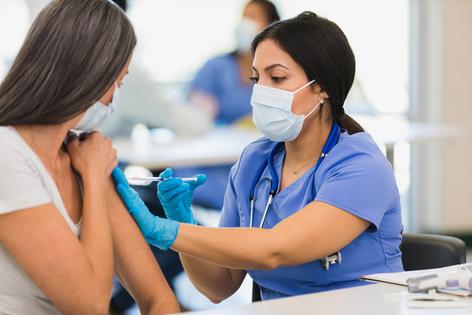When should you get the new COVID-19 booster and the flu shot? Now is the right time for both
Published in Health & Fitness
At this point in the COVID-19 pandemic, nearly everyone has experienced the panic and uncertainty that come with having mild COVID-like symptoms – such as a cough and sore throat – only to test negative day after day. With cold and flu season just around the corner, that state of frustrating uncertainty is likely to strike most of us again.
Both COVID-19 and the flu are contagious respiratory illnesses that have similar symptoms, making it difficult to distinguish between the two viral infections without a lab test. Testing is the only way to know which virus is causing your symptoms. In fact, labs are working to create one test that can detect both COVID-19 and the flu.
As a nursing professor with experience in public health promotion, I am often asked about the differences between the flu and COVID-19. This year I am fielding many questions about the timing of getting the new COVID-19 booster and the flu shot and whether they can be given together.
Symptoms of both COVID-19 and the flu can range from mild – or no noticeable symptoms at all – to severe. While flu infection does not typically affect one’s ability to taste or smell, loss of taste or smell has been a common symptom associated with COVID-19 infection. Both infections can cause fevers, chills, body aches and fatigue. More severe symptoms of either infection include difficulty breathing and subsequent infections like pneumonia.
During the 2021-2022 flu season, the term “flurona” made its way into the COVID-19 vernacular. Flurona refers to a simultaneous infection with both the flu and COVID-19. While only a few cases of co-infections have been reported, it would not be surprising to see more of them this coming flu season. Vaccination for both the flu and COVID-19 is your best protection against both.
With the newly formulated COVID-19 booster shot now available and flu season just around the corner, a natural question is whether there is an optimal timing for the two shots.
The answer to that question is to get both as soon as possible. It is important to consider that it takes approximately two weeks after vaccination for the body to develop antibodies from both the COVID-19 vaccines and the flu vaccine.
As long as you have completed your primary COVID-19 vaccine series and it has been at least eight weeks since your last COVID-19 booster, now is the time to get the updated COVID-19 vaccine that targets both the original strain of SARS-CoV-2 – the virus that causes COVID-19 – and the most recent omicron subvariants. The original COVID-19 vaccines and booster series have dramatically reduced the number of COVID-19 infection and death rates, as well as cases of severe COVID-19 that lead to hospitalization.
While everyone 6 months of age and older are recommended to receive both the COVID-19 and flu vaccines, certain populations have a higher risk for severe infection, such as pregnant women, and should be extra vigilant about getting vaccinated.
Further, among those vaccinated against COVID-19, symptoms during an infection tend to be milder. However, due in part to the quickly evolving nature of the virus, it’s become clear that immune protection from COVID-19 vaccination or infection does not last forever. While studies show that the primary COVID-19 series maintains efficacy against severe disease and death six months after vaccination, protection against infection decreases by between 20% to 30% by six months after vaccination.
This decline in immune protection is exactly why booster shots are so critical. Without a large uptake of booster shots in the population, COVID-19 infection rates could surge again.
Timing is also important with the flu vaccine. Flu cases typically begin to rise in October and peak between December and February, but can last through May. Ideally, people should get vaccinated before flu begins to spread, making September or early October the ideal flu vaccination time.
Due to lockdowns, reduced travel, school closures and mask mandates in the first and second years of the pandemic, both the 2020-2021 and 2021-2022 flu seasons were estimated to have fewer hospitalizations and deaths from the flu compared to many of the pre-pandemic years.
In the fall of 2021, experts became concerned about the potential for a COVID-19 and flu “twindemic,” especially as COVID-19 restrictions were lifting and masks were coming off. Fortunately, the worst didn’t bear out – flu numbers in the 2021-2022 season did not return to pre-pandemic levels. However, the possibility of a “twindemic” is not out of the picture for the coming flu season.
Flu seasons are inherently difficult to predict. With most people traveling again, schools open, mask mandates lifted and workers headed back to the office, people are undoubtedly going to be exposed to germs that they have been more protected from for the last two and a half years.
To further compound this, flu vaccine rates have been lower during the pandemic, suggesting that Americans may be out of the habit of getting their annual flu shot.
Many are also wondering whether they can or should get both the updated COVID-19 booster and the flu shot at the same time. The good news is, yes, it is safe for both adults and children 12 years of age and up who are eligible for the updated COVID-19 booster to get these vaccines simultaneously.
A recent study found that common vaccine side effects such as pain at the injection site occurred at slightly higher rates when someone received the flu vaccine and a COVID-19 vaccine at the same time, as opposed to receiving only a COVID-19 booster. However, those reactions, including fatigue and headache, were mild and resolved within a day or two.
You don’t need to make two separate vaccine visits as long as you are due for your next COVID-19 shot. However, I don’t recommend waiting to get your flu shot if you are not yet due for a COVID-19 booster. The Centers for Disease Control and Prevention suggests everyone receive their flu vaccine by the end of October. But if you miss that deadline, it is absolutely better to get vaccinated later in the season than not at all.
Getting the flu and COVID-19 vaccines isn’t just about your own health, it’s about family and community health too. Communities with higher vaccination rates have fewer opportunities to spread the virus.
Keep in mind that many people cannot be vaccinated because they have weakened immune systems or are undergoing treatments. They depend on those around them for protection. While one person may experience mild symptoms if they contract the flu or COVID-19, they could spread the virus to others who could become severely ill. Because it’s impossible to predict how people will react if they get sick, getting the flu and COVID-19 vaccines is the best prevention strategy.
This article is republished from The Conversation, an independent nonprofit news site dedicated to sharing ideas from academic experts. It was written by: Libby Richards, Purdue University. If you found it interesting, you could subscribe to our weekly newsletter.
Read more:
Even mild COVID raises the chance of heart attack and stroke. What to know about the risks ahead
When COVID-19 or flu viruses kill, they often have an accomplice – bacterial infections
Libby Richards has received funding from the National Institutes of Health. She is is affiliated with the American Public Health Association.











Comments